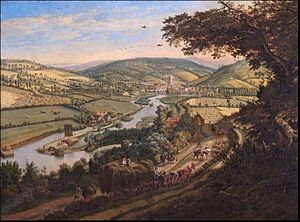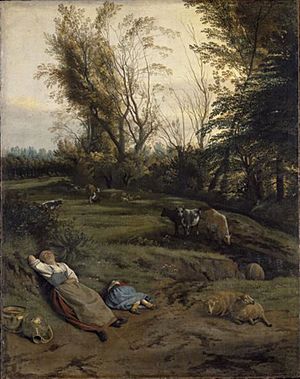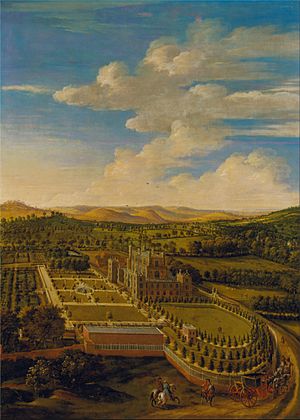Jan Siberechts facts for kids

Jan Siberechts (1627–1703) was a talented landscape painter from Flanders (modern-day Belgium). He became famous for his paintings of the countryside and everyday life. After a successful career in his home city of Antwerp, he moved to England later in his life.
In his early paintings, Siberechts showed the beauty of the Flemish countryside. His later works in England still had a Flemish feel, but they focused on bigger, more universal themes. He also painted special hunting scenes for rich English families. His detailed views of English estates helped start the tradition of landscape painting in England.
Life Story
Jan Siberechts was born in Antwerp. His father, also named Jan, was a sculptor. Jan Siberechts learned to paint from his father. By 1648, he became a master in the local Guild of Saint Luke, which was a group for artists.
It's possible he visited Italy in the late 1640s or early 1650s, but we are not completely sure. In 1652, he married Maria-Anna Croes in Antwerp.
Siberechts developed his own unique way of painting landscapes. His style impressed George Villiers, 2nd Duke of Buckingham, who visited Antwerp in 1670. The Duke then invited Siberechts to come and work in England.
Around 1672, Siberechts arrived in England. For his first three years, he painted decorations for the Duke's new home, Cliveden House. This house was in Taplow, Buckinghamshire.
From the late 1670s into the 1680s, Siberechts traveled a lot across England. He painted many pictures for wealthy families. He lived in London, where one of his daughters made lace for the Queen. His younger daughter, Frances, married two Flemish sculptors: Artus Quellinus III and later John Nost.
In 1696, Siberechts was asked to paint the Belsize Estate in London. This estate belonged to a banker named John Coggs. This painting is now displayed in the Tate Gallery in London. Jan Siberechts died in London. The famous painter John Wootton was one of his students.
His Artworks
About 100 of Jan Siberechts' paintings still exist today. His early works were influenced by Dutch landscape painters like Nicolaes Berchem and Karel Dujardin. These artists mostly worked in Rome. Siberechts likely saw their art in Antwerp, even if he didn't visit Italy himself.
In the 1660s, he created his own special style of landscape painting. He focused on the Flemish countryside and everyday country life. He often painted strong country girls in the foreground of his landscapes. These women wore bright red, blue, and yellow clothes.
He showed them traveling in carts, walking, or riding mules. They were often carrying baskets or bundles. Sometimes, they were crossing flooded roads or rivers. Siberechts made these figures stand out by placing them against brightly lit parts of the landscape. He also liked to show how figures looked when reflected in water. He sometimes painted farmyard scenes, similar to David Teniers the Younger. An example is Courtyard of a vegetable farm (1664), which is in the Royal Museums of Fine Arts of Belgium.
His later landscapes, painted in England during the 1670s and 1680s, kept their Flemish feel. However, they focused on universal ideas rather than just one specific view. This was different from Dutch paintings of the time, which often showed only one part of a landscape.
Siberechts' English landscapes featured strong trees and soft light on distant hills. The people in these paintings became less important than the landscape itself. He often kept the front of the painting darker. This helped draw the eye to the wide, brightly lit view in the background.
Siberechts also painted hunting scenes for his English clients. These were some of the earliest "country house portraits" in England. He often used a similar layout for these scenes. He would show the hunters and horses in the front. Behind them, he painted a realistic view of the grand country home. This was set in a misty, atmospheric landscape. He used a "bird's-eye view" to show as much detail as possible.
These country house portraits greatly influenced English landscape painting. Because of this, Siberechts is often called the "father of British landscape." These paintings are also important for showing how historic places looked. Siberechts started a long tradition of Flemish painters who created detailed views of British noble estates. Other artists who followed this tradition include Peter Tillemans, Pieter Andreas Rijsbrack, and Hendrik Frans de Cort.
See also
 In Spanish: Jan Siberechts para niños
In Spanish: Jan Siberechts para niños





